OSU baseball: What has happened to the Beavers’ bullpen?
Published 9:15 pm Wednesday, May 26, 2021

- Oregon State coach Mitch Canham.
At the start of the season, Oregon State adopted a nickname for it’s pitching staff: The Gauntlet.
The group was perceived to be so deep with talented starters and relievers that the nickname felt like an appropriate one at the time. Even if opposing batters managed to get after one pitcher, Mitch Canham had the option of choosing from at least a dozen other talented arms on a nightly basis.
But at the most important point of the season, the bullpen has turned out to be Oregon State’s Achilles heel.
In each of the Beavers’ last four conference baseball series, they have surrendered a lead in the eighth inning or later at least once and gone on to lose. Those games against UCLA, USC, Arizona State and Arizona have loomed large.
The sixth-place Beavers sit 4.5 games back of Arizona, which won the conference title in Corvallis last Sunday when it scored five unanswered over the final two innings to add another instance to an ever-growing list of recent bullpen mishaps.
“I think you can tell if a tough series happens and we have a big loss or something like that, guys will come out the next day and really try to overthrow the baseball,” Canham said. “Wanting to put the weight of the world on their shoulders and win it right away. It’s just like a hitter going up there to try and hit a grand slam with the bases empty. Like, ‘The team needs this.’ I think we just have to do a better job collectively not putting so much weight on ourselves and trying to do too much.”
Statistically speaking, Oregon State’s staff was among the best in the nation at the start of Pac-12 play. But after the Arizona series, only two relievers who have pitched a significant amount of innings own an ERA that is lower than 4.00 — Bryant Salgado, who has not surrendered an earned run in conference play, and Will Frisch, who is carrying a 1.29 ERA.
Often, the late-game failures have come at the expense of pitchers who have been reliable, shutdown relievers throughout their careers.
“I’d say the bullpen, we’ve had our ups and downs,” closer Jake Mulholland said. “I think that there started to be a few guys who have become really confident in their roles. I think that certain guys know when they’re going to pitch and when they’re not. But I don’t think there’s a guy in the bullpen who isn’t going to go out there and fight and compete when you give him the ball.”
Canham and pitching coach Rich Dorman have pin-pointed a few reasons for the recent struggles. Part of that, they believe, comes from pitchers overthrowing because they want so badly to succeed in a big moment.
But there’s also a human element at play.
“In an ideal situation, you know exactly what you’re going to get, right?” Canham said. “But you’re also dealing with college student-athletes who are still building up. Guys didn’t really throw last year. You’re constantly managing not only the mental, but the physical part of it . Trying to take into account how many pitches a guy threw and how he responded the next day.”
In many instances, walks have been at the heart of the late-game issues. Free passes came back to bite the Beavers in each of those aforementioned losses.
Oregon State doesn’t necessarily walk too many batters, per se, but when the Beavers do issue walks, they often come at the worst possible moments.
In 27 conference games, Oregon State’s pitching staff has walked 118 batters over 2401/3 innings.
For context, Arizona is the No. 6-ranked team in the country and has also walked exactly 118 batters this year over 2682/3 innings. Second-place Oregon has walked 91 batters in 245 innings.
The numbers show that the Beavers’ inning-to-walks ratio is not much worse than the top teams in the conference, and they also reflect that pitching to contact doesn’t necessarily always correlate with success. It’s had disastrous results for the two worst teams in the league.
But all of the aforementioned issues have culminated in Oregon State’s best relievers constantly working with runners on base in high-leverage situations.
“It just seems to happen at the wrong time for some guys,” Canham said of the walks. “But I really think that if we can flip it — instead of getting to a full count, and we start thinking 2-2, it makes us more competitive early on. But the reality is that we need to be getting after guys in three pitches or less, not fearing contact and allowing our defense to work.”






